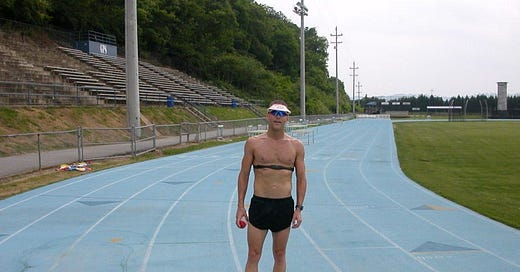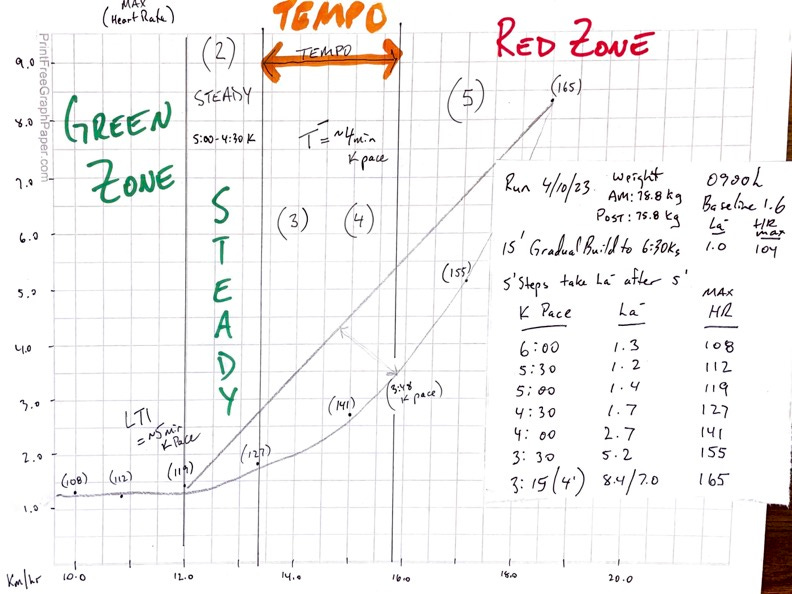Good Question From Tim on my article, Building Run Profiles.
Tim’s question refers to The Reality Check Workout.
What is the recommended WU and CD?
Example - for a 10K race, 3 x 2 with 1k between has you at 8K.
Simple answer for Tim, and you, is the minimum warm-up should be whatever you plan to use on Race Day.
Long answer follows with descriptions of:
Two-Stage Warm-ups
Cool Down
Tips For Health & Fitness Exercisers
Ultra & Ironman Warm-Ups
Advanced Warm-Ups For Red Zone Training
Cold Water Warm-Ups
Dry & Short Warm-Ups
As you’ll read, I like a long warm up. A warm-up which takes longer than 20 minutes becomes (endurance) training, and I find this supplemental volume useful.
Using The Bike To Warm-Up The Run
Most runners are limited by the number of foot strikes their bodies can tolerate.
As such, I like a two stage warm-up:
First Warm-up On The Bike
Second Warm-up Running
The idea being to use the bike to accelerate athletic development. The bike safely ramps aerobic volume, while improving the function of our mitochondria.
Nearly everyone can get an extra 3-5 hours of additional weekly training that will not impair run performance.
It’s the athletic equivalent of Free Money.
First Warm Up
One Hour of cycling moving through my Green Zone.
Ten Minute Steps
Cadence at, or over, 90 rpm
135 / 150 / 165 / 180 / 195 / 210 watts1
Entire range is inside my Green Zone
This is ~650 kilojoules of work and gives me a look into how I am feeling. The link is to my article on Dynamic Loading.
Second Warm-Up
After the ride, 30 minutes of running where I start by walking and gradually move up through my Green Zone.
The goal of the entire warm-up process is to arrive at the “work set” ready-to-go.
With a bike-focused warm up, the quality of my run is improved and the total amount of endurance training is increased.
Cool Down
I note how long it takes to walk my heart rate under 100 bpm. If it takes more than 2 minutes then it’s likely I created “strain” in the workout.2
Next priority is a recovery beverage: water, carbohydrate drink or mixed protein-carbohydrate drink. Depends on the nature of the session and how long until I need to train again.
Then light stretching, while my muscles are warm and filled with blood. This is very simple stretches: squats, calf extensions, lunges, quad stretches and feet (ideally without shoes). The idea is to take tension out of my lower body ASAP.
If it’s been a tough run session then my favorite cool down is an easy spin home on my bike.
Health & Fitness Exercisers
Howard made an excellent point about my favorite warm-up…
For many that would be the entire workout.
Yes.
At least 80% of your weekly volume is going to be similar to my warm-up protocol. The Building Blocks of Lifelong Athleticism lays out the rest of the program.
John Hellemans makes an additional point: as we are adding Specific Capacity training to the eBook, we should define “for whom” the advanced techniques apply.
We’re going to do that next Monday’s by comparing & contrasting:
Elite Athletes
Competitive Athletes
Recreational Athletes
Warming-Up For Ultras
If finishing is going to be a challenge then don’t warm up.
Treat the first hour(s) of your day as a warm-up.
Warming-Up For Ironman
Most everyone paces an Ironman upside down.
Fast
Steady
Survive
If you are new to the distance then treat the entire swim as your warm-up.
Warm-up Swim
Easy to Steady Ride
Steady to Moderately-Hard Run
Before the swim, do enough exercise to raise your core body temperature, then hold back until the mid-point of the marathon.
Once you’ve run the marathon to your potential, continue to treat the swim as a warm-up and start to optimize bike pacing.
My conversation with Eric Schwartz digs deep on Ironman training and pacing.
Cold Water Warm-Ups
My cold water warm up:
Get the wetsuit on
Do enough activity to feel warm inside the suit
Go shin deep in the water, no further
Splash water on face and neck
Continue until I can place face in water and not gasp
Get out
Return to water, just before start
Repeat face/neck prep
Start relaxed pace
The idea being…
If I'm going to have an adverse reaction then I want to have it OUT of the water.
I want to be able to put my face into the water, and breathe, once the race starts.
These tips will make more sense the first time you race in really cold water.
For more on the Physiology of Cold Exposure, I recommend Jørgen Melau’s Substack.
Advanced Warm-Up For Red Zone Running
My favorite warm-up for fast run sessions:
3200m Easy Effort
3200m, Steady Effort (benchmark pace to heart rate)
3000m, Moderately-Hard Effort (benchmark pace +10 bpm from Steady Heart Rate)
4-6 Strides on Walking Recoveries
The Easy-Steady-ModHard running progression is done continuously with K spilts and heart rate data gathered for the final 3km of each step.3
For more on benchmarking at the track see: Benchmarking Over Time in Your First Track Session.
Hellemans Race Warm-Up
John’s had the same warm-up for decades.
His warm-up is so quick, we never knew if he was going to race until the gun went off. Even then, sometime he’d line up off to the side and we’d miss him.
Scott Molina had a similar tactic. They both kept us guessing.
Here is John’s approach:
Warm-up before racing is personal.
Main thing is to start the race feeling warm.
The anticipation of racing has a physiological effect (fight/flight response), which will get the body ready for action. For some people that is enough.
I never warm up much before races, just swing my arms around to get the blood flowing before the swim.
John’s arm-swing warm-up is an extreme example of the short warm-up.
For Red Zone Training, John recommends 10-20 minutes of Easy Exercise followed by up to 6 accelerations.
I’ve found that heart rate response during the accelerations is a useful indicator of whether the athlete is ready to go. If heart rate response is quick then fewer accelerations are needed.
Dry Warm-Up For Triathlon
We’re fortunate to have a friendly squad of elite triathletes in Boulder, some of whom have medalled.
The Tri Olympians do a “dry warm-up” before every swim. They use swim cords.
The dry warm-up gives them three advantages on race day:
They can warm-up anywhere, at any time.
They never need to get wet, and run the risk of getting cold, prior to a race start.
A delay in the start time, has no impact on their race.
Back To Table of Contents
This range represents Recovery through to just over First Lactate Threshold. If you feel your breathing rate change then ease off the effort.
Load, Stress & Strain video by Stephen Seiler is worth your time.
A Case Study from my Elite Days is The 20K Track Session. Slide down and check out the benchmark paces for Clas Björling, a low 2:40 off-the-bike marathoner.







Thx for the tips. The line in beginning “most runners have limited # of foot strikes” really hit home for this 200+ pounder. Definitely something I have to manage.
The Hellemans short warm and correlation to fight/flight response is interesting. I’ve kinda suspected this based on some race morning experiences that I’ve had, but this is the first time that I’ve seen something like that in writing.